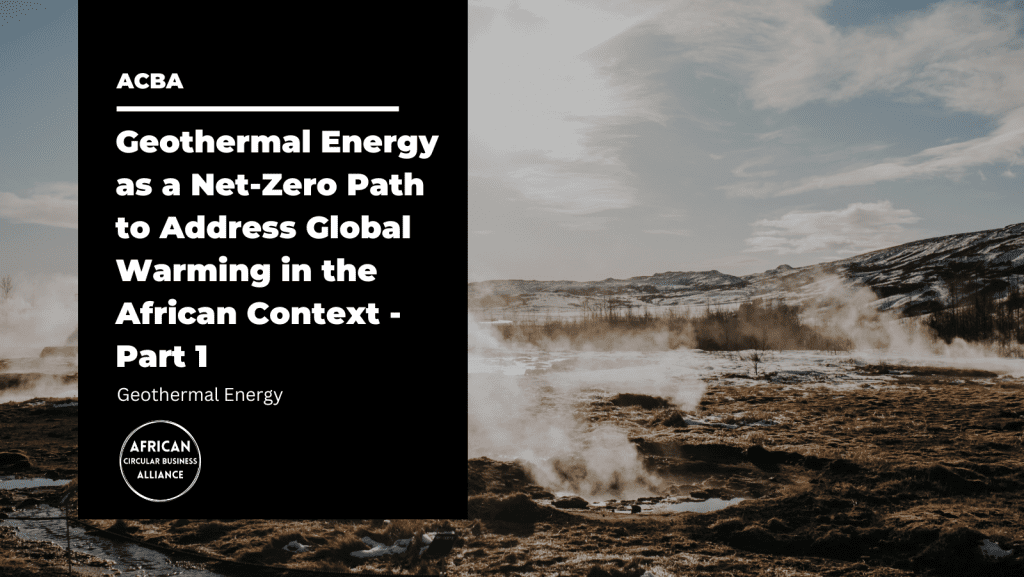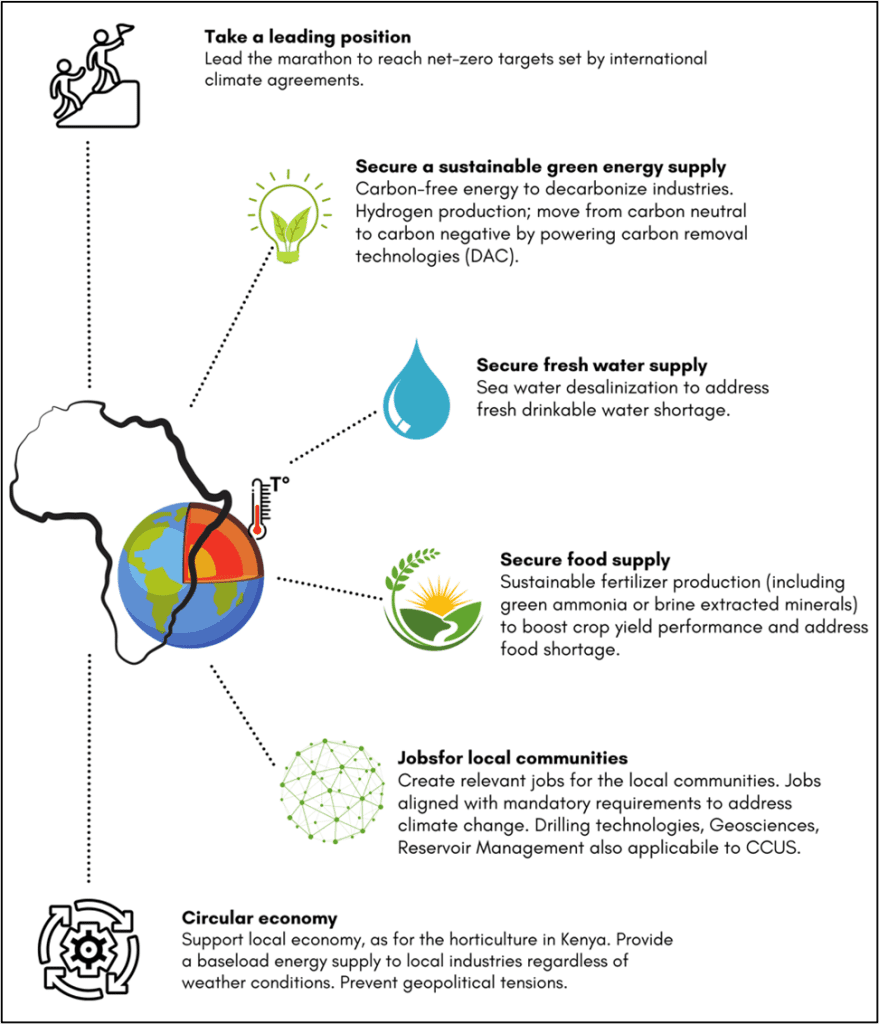This article was authored by Wilfried Bero and received contributions from Nair de Sousa, Miguel Peters, and Dr Rita Okoroafor.
… no continent in the world could be as positively impacted as Africa when it comes to benefiting from geothermal energy.

Fighting global warming is most probably one of the toughest challenges faced by humanity. No matter your location in the world, you have probably been impacted by climate change signals. Shall it be the sea level rise causing nations to relocate, or large-scale wildfires causing communities to suffocate, the climate change signals can no longer be ignored.
Although the climate itself has always been changing through cyclic geological times, there are current debates among specialists censuring induced human activities as the origin of global warming. For this reason, a certain sense of emergency subsists as the clock is ticking in the face of increasingly alarming events that demonstrate the urgency and need to produce alternative smarter forms of energy for sustaining current energy demand and challenges in Africa.
In fact, there is no silver bullet to overcome this challenge but there is one technology that comes close to one of the solutions which is Geothermal, a baseload renewable energy, carbon emission-free, available 24/7 until the end of time paving the way toward a net-zero economy.
The marathon towards this green energy has begun worldwide and some African nations are already up to speed to hold a leading position. Kenya, which launched an investigation into geothermal energy during the late 1970s, is already ahead of the curve as part of the Top 10 countries developing this technology, as stated by Elbarbary et al (2022).
Kenya, known for its industry based on renewables, is ranked eighth among the world’s largest geothermal energy producers, with about 860 MW of installed power capacity since 2019. In such a context, this African country is ranked ahead of Iceland. From its leading position, Kenya represents a success story to inspire the surrounding African nations to do the same. As shown on the following map, up to 14 countries in Africa present good geothermal potential (namely Algeria, Botswana, Djibouti, Democratic Republic of Congo, Egypt, Ethiopia, Ivory Coast, Kenya, Liberia, Namibia, South Africa, Tanzania, Uganda and Zambia).

The regions highlighted on the map are an exceptional asset on the continent to secure a regional carbon-neutral energy supply infrastructure where resources could be sustainably shared to advance the technology required for a net-zero economy. Assuming that such technologies succeed, geothermal could be developed in more than just 14 countries on the continent. Rightfully so, as no continent in the world could be as positively impacted as Africa when it comes to benefiting from geothermal energy.
The abundance of resources in Africa feeding the global energy market can be qualified as limitless. Not only Africa has been able to feed the world’s energy demand with good oil quality over decades, but it also has more than one trick up its sleeve. Africa can lead and showcase a perfect energy transition road map due to its suitable geological advantage of having perfect reservoirs targeted within hot, tectonically stressed, and fractured rocks. Although those fractures have sealed over time resulting in lower permeability and little or no production of fluids, a combination of hydraulic, thermal, and chemical processes can be used to stimulate these fractures to open and interconnect. This creates a conductive fracture network that is equivalent to conventional geothermal reservoirs and can be used toward increasing the viability and deployment of geothermal heat and power.
What makes Geothermal so attractive in Africa?
Despite an abundance of hydrocarbon resources initially in place in Africa, energy deprivation has been a serious issue in different places on the continent, leading some local communities to miss the opportunity to further develop a healthy economic situation. The forever-growing world energy demand has always applied reckless pressure on African countries with limited hydrocarbon resources. This challenging situation requires innovation for the use and quantification of alternative resources. For this reason, one key element that makes Geothermal so relevant and attractive in Africa is not only its suitable geological context but also its large geographical extension across border countries with underexploited potential.
Geothermal energy could be developed in Africa in a more sustainable way in prominent countries such as Djibouti, Kenya, Uganda, Ethiopia, and Tanzania which have the greatest potential for electricity generation from geothermal. All these countries together should create a strategic design to build a regional infrastructure and an effective business cluster network. This could accelerate an expansive deployment of the technology throughout the continent for the benefit of the surrounding nations with lower geothermal potential.

Different from many European countries, Africa is blessed with the benefit of having a shorter domestic market where it is much easier to produce hydrogen at closer locations to where it is to be consumed. Considering the challenges of transporting hydrogen due to its low energy density and high storage, a shorter market in Africa allows more opportunities for producing green hydrogen, with minimal transportation and storage costs. This would enable African nations and Africans to take the lead in the marathon toward a net-zero economy by meeting Africa’s growing energy demand in multiple profitable ways.
Additionally, the renewable aspect of Geothermal energy and its nature-derived characteristics give space to a circular economy in Africa by improving access to clean energy consumption while exponentially reducing CO2 emissions. As geothermal power exploits the heat from the subsurface, there is no combustion required, which makes it a low-carbon technology. Being available 24/7, all year round regardless of weather conditions, geothermal can be the baseload component of the energy mix, as a pivotal vehicle to reach international climate agreement targets. It will also enable African countries to produce relevant and more attractive Nationally Determined Contributions (NDCs).
Africa Taking the Lead to a Decarbonized World from Geothermal
Geothermal energy systems use natural steam or very hot water trapped in deep rock formations to generate geothermal electricity that provides abundant low-carbon energy. A variant, the Enhanced Geothermal System (EGS), uses very hot water derived from circulating water through deep hot formations with enhanced flow paths created through a variety of hydraulic stimulation methods. To generate electricity, a Dry Steam Geothermal Power Plant, Flash Steam Power Plant or a Binary Cycle Geothermal Plant that uses a turbine to generate electricity may be utilized. All of these systems operate with very minimal environmental damage where there are exploitable geothermal resources such as heat, water, and sufficient rock permeability underground. These technologies allow energy extraction and create circular economy opportunities that could be used to leverage sustainable development in Africa in the following ways:
Water desalinization for fresh water supply: As seawater is an abundant resource surrounding the continent, it could be used in desalination plants to produce fresh drinkable water. This energy-demanding technology (Recycle Waste Water System) could be powered by geothermal. Desalination is vital, as it can address water scarcity among local communities in Africa. According to the United Nations, Sub-Saharan countries remain at a low 60% of safe water coverage, leaving 40% of the 783 million people in that region without access to clean water under hostile climate conditions. So, water shortages can therefore be tackled, not only for drinkable water supply but also for the agriculture industry.
Brine mineral extraction for agriculture: The geothermal brine from the subsurface contains minerals such as phosphorous and potassium that can be used as fertilizers and pesticides for improving plant growth. This makes Geothermal a good candidate to address food shortages in Africa.
Brine mineral extraction for Electric Mobility: The exponential growth of the electric mobility industry increases the global demand for critical minerals such as Lithium. The lithium concentrated in the geothermal brine can be extracted and commercialized as a by-product whilst operating a geothermal power plant. Lithium-ion batteries are essential in portable electronic devices such as smartphones, portable computers and also for energy storage efficiency in electric vehicles. This demonstrates how crucial is Geothermal in the energy transition worldwide, especially in developing economies such as in Africa.

From Green Hydrogen to Green Ammonia for Agriculture: Green Hydrogen is produced by water electrolysis powered by renewable energy sources. Its conversion into green ammonia presents good opportunities for economic diversification and growth. It can be used as a fertilizer for agriculture which is a good substitute for traditional nitrogen fertilizers that contain a larger carbon footprint. As stated by Smith & Torrente-Murciano (2020), ammonia from N-fertiliser should not be used in developing countries due to soil degradation and other safety considerations but it can be converted to urea, ammonium bicarbonate or ammonium sulfate.
From Green Hydrogen to Green Ammonia for Energy Transportation: The production of green ammonia is also promising in addressing several energy supply chain challenges. It can be used as a clean, carbon-free fuel for efficient maritime transportation. Green ammonia has a much higher energy density, making it easier to transport and store.
From Carbon Neutral to Carbon Negative: Geothermal plays a critical role in creating a carbon-negative economy by being a net-zero energy source to power Carbon Removal technologies such as Direct Air Capture (DAC) facilities. Those technologies are still relatively young with a large progress margin. Although far from being mature, it offers the priceless advantage of removing CO2 directly from the ambient air. By being powered by geothermal, DAC facilities, go beyond being just carbon neutral as geothermal helps go carbon negative. Such projects are already being developed in Europe and in the US and can be massively scaled up in Africa as well.
End of Part I. Watch out for Part II on the hindrances to geothermal energy development in Africa and how they can be overcome.
PS: Are you a Government, Business or Organisation willing to understand more about Geothermal Energy? Please get in touch with us!
